The SM-65 Atlas was the first operational intercontinental ballistic missile (ICBM) developed by the United States and the first member of the Atlas rocket family. It was built for the U.S. Air Force by the Convair Division of General Dynamics at an assembly plant located in Kearny Mesa, San Diego.
A propellant is a mass that is expelled or expanded in such a way as to create a thrust or another motive force in accordance with Newton's third law of motion, and "propel" a vehicle, projectile, or fluid payload. In vehicles, the engine that expels the propellant is called a reaction engine. Although technically a propellant is the reaction mass used to create thrust, the term "propellant" is often used to describe a substance which contains both the reaction mass and the fuel that holds the energy used to accelerate the reaction mass. For example, the term "propellant" is often used in chemical rocket design to describe a combined fuel/propellant, although the propellants should not be confused with the fuel that is used by an engine to produce the energy that expels the propellant. Even though the byproducts of substances used as fuel are also often used as a reaction mass to create the thrust, such as with a chemical rocket engine, propellant and fuel are two distinct concepts.

Rocketdyne was an American rocket engine design and production company headquartered in Canoga Park, in the western San Fernando Valley of suburban Los Angeles, in southern California.

The PGM-17A Thor was the first operative ballistic missile of the United States Air Force (USAF). It was named after the Norse god of thunder. It was deployed in the United Kingdom between 1959 and September 1963 as an intermediate-range ballistic missile (IRBM) with thermonuclear warheads. Thor was 65 feet (20 m) in height and 8 feet (2.4 m) in diameter.

The Delta rocket family was a versatile range of American rocket-powered expendable launch systems that provided space launch capability in the United States from 1960 to 2024. Japan also launched license-built derivatives from 1975 to 1992. More than 300 Delta rockets were launched with a 95% success rate. The series was phased out in favor of the Vulcan Centaur, with the Delta IV Heavy rocket's last launch occurring on April 9, 2024.

The PGM-19 Jupiter was the first nuclear armed, medium-range ballistic missile (MRBM) of the United States Air Force (USAF). It was a liquid-propellant rocket using RP-1 fuel and LOX oxidizer, with a single Rocketdyne LR79-NA rocket engine producing 667 kilonewtons (150,000 lbf) of thrust. It was armed with the 1.44 megatons of TNT (6.0 PJ) W49 nuclear warhead. The prime contractor was the Chrysler Corporation.

The Rocketdyne H-1 was a 205,000 lbf (910 kN) thrust liquid-propellant rocket engine burning LOX and RP-1. The H-1 was developed for use in the S-I and S-IB first stages of the Saturn I and Saturn IB rockets, respectively, where it was used in clusters of eight engines. After the Apollo program, surplus H-1 engines were rebranded and reworked as the Rocketdyne RS-27 engine with first usage on the Delta 2000 series in 1974. RS-27 engines continued to be used up until 1992 when the first version of the Delta II, Delta 6000, was retired. The RS-27A variant, boasting slightly upgraded performance, was also used on the later Delta II and Delta III rockets, with the former flying until 2018.

Atlas II was a member of the Atlas family of launch vehicles, which evolved from the successful Atlas missile program of the 1950s. The Atlas II was a direct evolution of the Atlas I, featuring longer first stage tanks, higher-performing engines, and the option for strap-on solid rocket boosters. It was designed to launch payloads into low Earth orbit, geosynchronous transfer orbit or geosynchronous orbit. Sixty-three launches of the Atlas II, IIA and IIAS models were carried out between 1991 and 2004; all sixty-three launches were successes, making the Atlas II a highly reliable space launch system. The Atlas line was continued by the Atlas III, used between 2000 and 2005, and the Atlas V which is still in use.

Aerojet Rocketdyne is a subsidiary of American defense company L3Harris Technologies that manufactures rocket, hypersonic, and electric propulsive systems for space, defense, civil and commercial applications. Aerojet traces its origins to the General Tire and Rubber Company established in 1915, while Rocketdyne was created as a division of North American Aviation in 1955. Aerojet Rocketdyne was formed in 2013 when Aerojet and Pratt & Whitney Rocketdyne were merged, following the latter's acquisition by GenCorp from Pratt & Whitney. On April 27, 2015, the name of the holding company, GenCorp Inc., was changed to Aerojet Rocketdyne Holdings, Inc. Aerojet Rocketdyne Holdings was acquired by L3Harris in July 2023 for $4.7 billion.
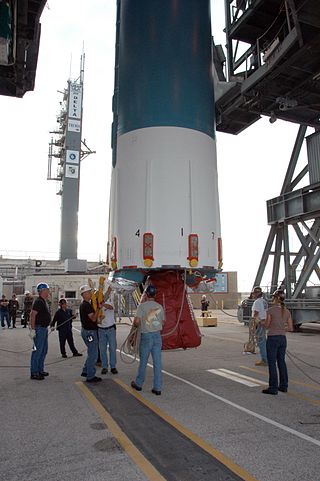
The RS-27A is a liquid-fuel rocket engine developed in 1980s by Rocketdyne for use on the first stage of the Delta II and Delta III launch vehicles. It provides 1.05 meganewtons (240,000 lbf) of thrust burning RP-1 and LOX in a gas-generator cycle. The engine is a modified version of its predecessor, the RS-27; its thrust nozzle has been extended to increase its area ratio from 8:1 to 12:1, which provides greater efficiency at altitude.

A vernier thruster is a rocket engine used on a spacecraft or launch vehicle for fine adjustments to the attitude or velocity. Depending on the design of a craft's maneuvering and stability systems, it may simply be a smaller thruster complementing the main propulsion system, or it may complement larger attitude control thrusters, or may be a part of the reaction control system. The name is derived from vernier calipers which have a primary scale for gross measurements, and a secondary scale for fine measurements.

The Atlas III was an American orbital launch vehicle, used in the years between 2000 and 2005. It was developed from the highly successful Atlas II rocket and shared many components. It was the first member of the Atlas family since the Atlas A to feature a "normal" staging method, compared to the previous Atlas family members, which were equipped with two jettisonable outboard engines on the first (booster) stage. The Atlas III was developed further to create the Atlas V.
Thor was a US space launch vehicle derived from the PGM-17 Thor intermediate-range ballistic missile. The Thor rocket was the first member of the Delta rocket family of space launch vehicles. The last launch of a direct derivative of the Thor missile occurred in 2018 as the first stage of the final Delta II.
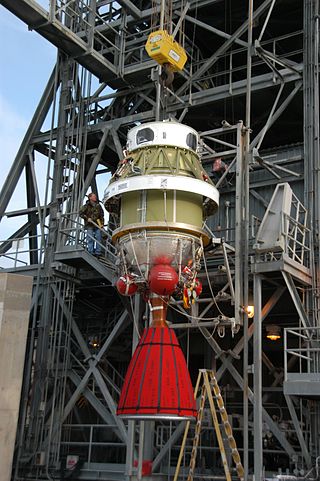
The AJ10 is a hypergolic rocket engine manufactured by Aerojet Rocketdyne. It has been used to propel the upper stages of several launch vehicles, including the Delta II and Titan III. Variants were and are used as the service propulsion engine for the Apollo command and service module, in the Space Shuttle Orbital Maneuvering System, and on the European Service Module – part of NASA's Orion spacecraft.

The SM-65C Atlas, or Atlas C was a prototype of the Atlas missile. First flown on 24 December 1958, the Atlas C was the final development version of the Atlas rocket, prior to the operational Atlas D. It was originally planned to be used as the first stage of the Atlas-Able rocket, but following an explosion during a static test on 24 September 1959, this was abandoned in favor of the Atlas D. Atlas C was similar to Atlas B, but had a larger LOX tank and smaller RP-1 tank due to technical changes to the Rocketdyne engines. Improvements in materials and manufacturing processes also resulted in lighter-weight components than the Atlas A and B. Booster burn time was much longer than the A/B series, up to 151 seconds. All launches took place from LC-12 at CCAS.

The SM-65D Atlas, or Atlas D, was the first operational version of the U.S. Atlas missile. Atlas D was first used as an intercontinental ballistic missile (ICBM) to deliver a nuclear weapon payload on a suborbital trajectory. It was later developed as a launch vehicle to carry a payload to low Earth orbit on its own, and later to geosynchronous orbit, to the Moon, Venus, or Mars with the Agena or Centaur upper stage.
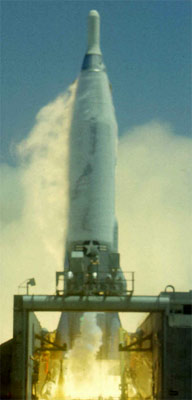
The SM-65E Atlas, or Atlas-E, was an operational variant of the Atlas missile. It first flew on October 11, 1960, and was deployed as an operational ICBM from September 1961 until April 1966. Following retirement as an ICBM, the Atlas-E, along with the Atlas-F, was refurbished for orbital launches as the Atlas E/F. The last Atlas E/F launch was conducted on March 24, 1995, using a rocket which had originally been built as an Atlas E.
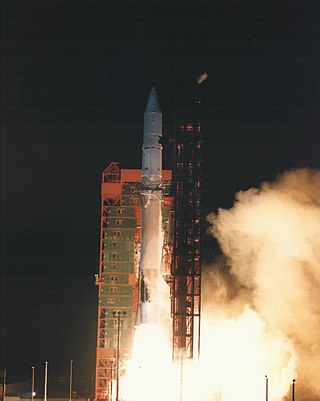
The Atlas G, also known as Atlas G Centaur-D1AR was an American expendable launch system derived from the Atlas-Centaur. It was a member of the Atlas family of rockets and was used to launch seven communication satellites during the mid to late 1980s. Atlas G consisted of an improved Atlas core with modernized avionics and stretched propellant tanks. The Centaur stage also had several updated components and other technical improvements. Atlas G flew 7 times, with all missions aiming to go to a geostationary transfer orbit. It was replaced by the near-identical Atlas I, which had an improved guidance system and offered a larger payload fairing.
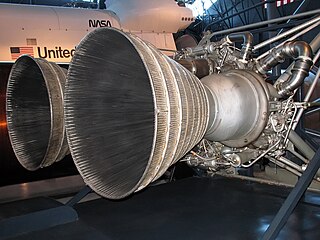
The LR87 was an American liquid-propellant rocket engine used on the first stages of Titan intercontinental ballistic missiles and launch vehicles. Composed of twin motors with separate combustion chambers and turbopump machinery, it is considered a single unit and was never flown as a single combustion chamber engine or designed for this. The LR87 first flew in 1959.

Since the founding of SpaceX in 2002, the company has developed four families of rocket engines — Merlin, Kestrel, Draco and SuperDraco — and is currently developing another rocket engine: Raptor, and after 2020, a new line of methalox thrusters.


















